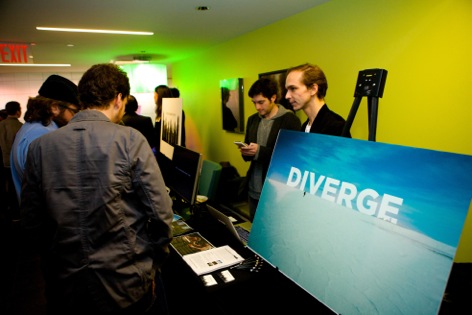By James Belfer
Ted’s note: We were fortunate to have James & Dogfish participate at our #A2E On Ramp program this past spring. I am excited by applying techniques from other industries to indie film. The Dogfish Accelerator borrows the structure of tech start ups, and utilizes mentoring and group learning to push it all forward. I expect we will hear great things from the different participants as time goes on. I think we will all want to track Dogfish Accelerators’ progress going forward.
Hello and welcome to Dogfish Accelerator’s Demo Day 2013. My name is James Belfer and I’m excited to present the 8 companies of our inaugural Dogfish Accelerator program. These teams have spent the last three months laying the foundation for the opportunities they are presenting today and I can’t wait for you to see what they’ve put together.
In 2009 I began Dogfish Pictures to learn about the landscape of independent film for investors. Over the course of my first two years I invested and/or worked on four films ranging in budget from $300K to $16M, premiered and sold 3 films at Sundance, and saw distribution deals for all four of these projects. During that time I experienced firsthand the many challenges the independent film industry faces.

As I reflected upon this hectic beginning I came up with two things I needed to do. First was sleep for about a month straight. And, second was to focus my future efforts on helping to repair a troubled independent film industry.
Despite keynote speeches from major figures in the industry touting the need for a major shift in the business of film and premium content, our industry still remains challenged today. “Times are tough” is the general mantra and yet only limited strategies are offered for turning the business around.
The real issue isn’t that the times are tough, it’s that you can’t be disruptive without knocking down a few walls. Or without trying new investment and business models, testing new marketing and monetization strategies, or utilizing distribution opportunities across multiple platforms. In short, we need to think and act like startups.

Dogfish Accelerator was built to confront these challenges and turn them into opportunities. We provide seed financing, mentorship, perks, resources and office space to teams of producers looking to develop their business models in preparation for further fundraising. We make the creative process easier by taking care of the business process from the start.
What will follow from this approach isn’t an implosion of our industry or impending doom. What will follow is a new generation of creators and thinkers willing to try new and amazing things.
We chose the 8 teams that make up this year’s Dogfish Accelerator from 440 applications we received. They are not the “NEXT” generation of content creators they are “TODAY’S” fearless, forward-thinking, content leaders. Our teams are the essence of what it means to be independent in today’s world of film and media.

Collectively we’ll be discussing 13 films, 3 marketing and distribution platforms, 2 Multi Channel Networks, and ancillary streams of revenue including graphic novels, video games, and a fashion line. To put it lightly, our 8 teams have been busy. But they haven’t been working alone. Our extensive mentor network has helped them explore and better understand the challenges of our industry and devise plans of attack. The support we have received from the independent film community has been tremendous and ongoing.
We are also excited to announce that some of our mentor relationships have blossomed into investments by our mentors. Anthony and John Gentile, founders of Gentile Entertainment Group and their new company, Platinum Media Group, whose partners include some of the most prominent names in our industry, were so impressed by the teams they mentored that they have already committed as lead investors on four of our team’s projects.
There are several things that a Dogfish team has in common, setting them apart from the pack. I want to mention a few of them:
MARKETING: Producers complain about distributors and distributors complain about producers. Neither side seems to be doing enough work to get enough eyeballs on our content. Our teams are repairing that by reducing the risk for the distributor by developing their marketing strategies at the beginning of the process. This means having marketing capital as part of their total budgets and helping with the heavy lifting of aggregating communities and consumers in order to convert them into sales. It enables producers and distributors to work together in a more collaborative manner.
DISTRIBUTION: All our teams have distribution secured right now. Paul Graham of Y Combinator once said: “Don’t reject an acceptable offer in the hope of getting a better one in the future.” The new platforms and software available today have made possible a revolution from the very recent time when distribution was a rare commodity. Following what the entire internet software industry has been doing for decades, our teams generate revenue streams to investors through direct to consumer sales. This approach also improves valuation on content IP and allows consumer traction to enter the process of securing larger distribution partnerships.

WORK EFFORT, COMMITMENT TO QUALITY AND FOCUS ON ENTERPRENEURSHIP: In choosing our teams Dogfish focused on those where the companies, its projects and the daily lives of its founders were one and the same. Our founders are living, breathing entrepreneurs. They are the leaders of original content startups and are developing strategies to create sustainable careers for themselves and their growing companies. A supportive relationship between art and commerce can lead to social and financial reward for everyone involved. Our teams not only recognize this, it comes naturally to them.
Dogfish is an organic and growing company itself. What began as a 3-month training program based on the accelerator model used by the technology industry has now extended for additional 3 months so we can ensure that our teams will continue to grow, successfully capitalize their projects and execute their businesses in a responsible and rewarding manner. And, although this is still a work in progress, it seems quite likely that the accelerator model will act as the front gate for a larger business studio that will support these and future teams far into the future. Next year I hope to be talking to you about Dogfish Studios.

But Dogfish is more than just a company; it’s a community. One in which we laugh, we cry, we triumph, we fail, and form relationships that will last a lifetime. If you hear a concept or idea you like today and want to share in our founders’ visions and successes please contact the teams or Dogfish directly and we can help you find a role.
Fred Wilson of Union Square Ventures said YESTERDAY on his blog AVC: “We haven’t yet built enough technology, distribution, and monetization systems so that filmmakers can be truly independent and realize their vision and have the financial success that should come with great work. So there is more to do here.” AT DOGFISH ACCELERATOR WE ARE DOING IT!
Now please enjoy our presentations and we look forward to our future conversations.
Auralnauts
Auralnauts is a creative production company distributing material through their popular Youtube channel. The mixture of comedy and music production has been consumed by over 9 million viewers to date. Known for lampooning films and television commercials with their own take on the dialogue and soundtracks, they are preparing a slew of new material they have produced from the ground up. Join the adventure at https://www.youtube.com/user/Auralnauts.
EXIT STRATEGY
EXIT STRATEGY is an award-winning company that tells engaging, substantive stories across rich cross-platform experiences. It was founded by Ryan Koo and Zack Lieberman who together wrote, directed and produced the “urban western” Webby-award winning series THE WEST SIDE. Koo is the founder of the popular filmmaking website NO FILM SCHOOL and Lieberman won an Emmy for his work at Sony Pictures Television. EXIT STRATEGY has also helped build a network of websites that garner over 50 million combined monthly page views for a number of high-profile clients. Find out more online at www.exitstrategy.tv.
Go Infect Films / LIKE ME
Go Infect Films is a film collaboration between writer/director Robert Mockler, producer Jessalyn Abbott and actress Mitzi Peirone. In partnership with Dogfish Pictures the team is accelerating its freshman feature film LIKE ME which follows Kiya, a fameobsessed young woman who documents a string of robberies through social media. LIKE ME was named one of IndieWire’s Projects of the Month in 2013 and is currently in contention for IndieWire’s Project of the Year.
Guagua Productions
Guagua Productions makes films with a subversive edge that take on exploitative institutions and make you think differently about subjects you thought you knew. The company builds audiences out of communities, not demographics, and using direct-to-fan distribution give consumers what they want, how they want it. Guagua Productions has produced, directed and released two feature length documentaries: Ballplayer: Pelotero and Schooled: The Price of College Sports.
Range Life Entertainment
Range Life Entertainment is a film marketing company that specializes in college tours, event screenings, and guerrilla marketing to build audience and exposure for films and brands. Range Life’s nationwide network includes over 260 schools, and the company has worked on over 40 films since 2008, including: Exit Through The Gift Shop, Mystery Team, The Imposter, andTeenage Paparazzo. In 2014, Range Life plans build toward the next phase of the company, which includes larger form events, year-round satellite engagements, and an extended digital presence through a platform based app.
Section II
Section II is the only multi-platform network designed specifically for curated, lesbian-related content. It acquires, creates, and distributes premium films and series to a growing audience that remains underserved. Section II is a Benefit Corporation and brand with a mandate to improve the representation of queer women in popular culture.
Wheelhouse Pictures
Wheelhouse Pictures is a creative production company that focuses on quality, character driven narratives that appeal to underserved communities and markets. The company was founded by partners Jessica Caldwell and Andrew Hauser, who are hands on from creative development right through to post-production.
Young Gunner Films
Young Gunner Films is a creative development and production company that takes a Lean Startup-inspired approach to the marketing and release of its films. The company develops its audiences alongside production and plans to retain a high percentage for each subsequent film. Its initial slate includes 3 ambitious high-concept genre films to be produced for under $1M each.
And here’s Filmmaker Magazine’s takeaway on the event.

 By nature, an artist who looks to distribute their work is an
By nature, an artist who looks to distribute their work is an 

 Who was the person who decided that the plain vanilla word “content” was going to stand for all the stuff that gets put up on social media?
Who was the person who decided that the plain vanilla word “content” was going to stand for all the stuff that gets put up on social media?






